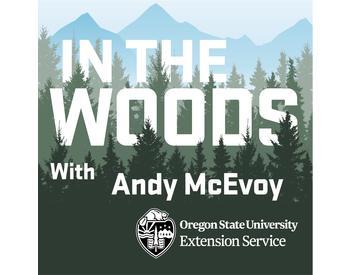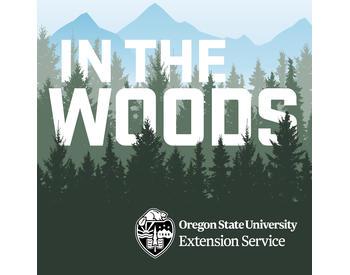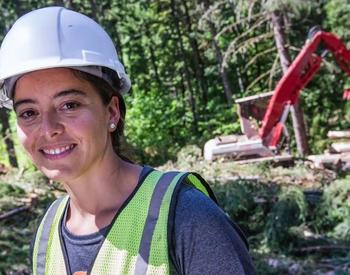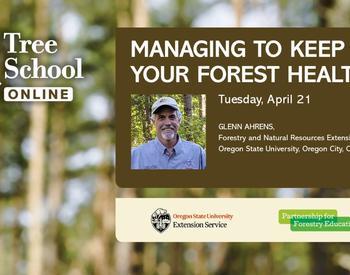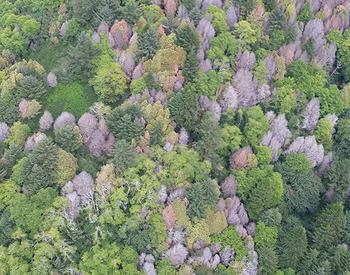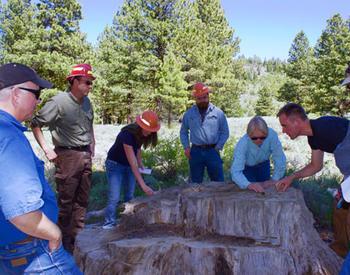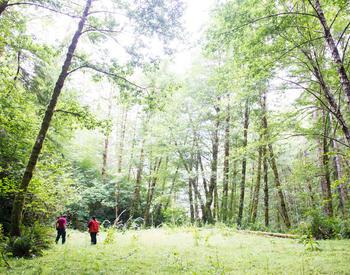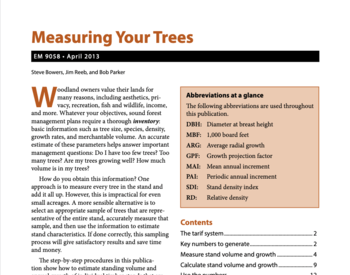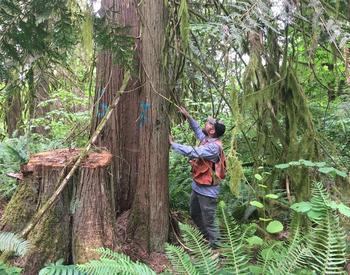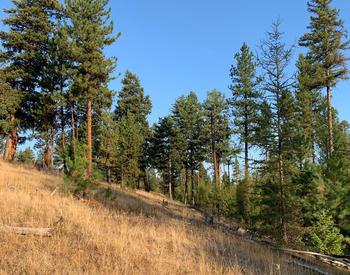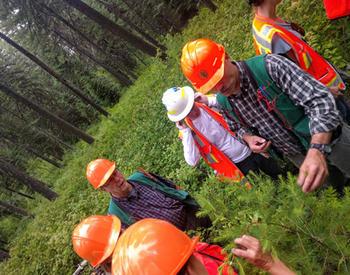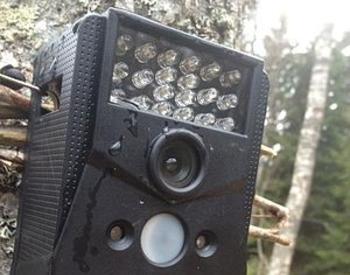Transcript
In The Woods - Episode 48 - Reducing fire risk in Northwest Oregon
Lauren Grand: From the Oregon State University's Extension Service, you are listening to In the Woods with the Forestry and Natural Resources Program. This podcast brings the forest to listeners by sharing the stories and voices of forest scientists, land managers, and enthusiastic members of the public. Each episode, we will bring you research and science based information that aims to offer some insight into what we know and are still learning about forest science and management.
Stick around to discover a new topic related to forests on each episode.
Hey, welcome back to another episode of in the woods. I'm Lauren Grand OSU extension forestry and natural resources extension agent and associate professor of practice in Oregon state university's college of forestry. Today, I feel extra special because I have a guest host with me from the forestry and natural resources extension team.
Welcome to the podcast again, Aaron.
Aaron Groth: Thanks so much, Lauren. Appreciate you having me. My name is Aaron Groth. I'm the regional fire specialist for the coast with FNR extension fire program.
Lauren Grand: Great. Yeah.
So we'll together be your hosts for today's episode, and we've got a hot topic to discuss. We'll be talking about potential fire hazards in the Northwest Oregon region and steps that people can take to protect their homes and communities.
Aaron Groth: This episode highlights fire hazard for northwest Oregon. Most large fires in northwest Oregon, such as the Tillamook burn of 1933, occur under extreme weather conditions, proceeding drought and east wind events.
Human ignitions play an outsized role, accounting for about 90 percent of ignitions in the coast area.
Lauren Grand: , thanks, Aaron.
Today we're joined by two guests Mike Caffaretta, who's the Oregon Department of Forestry, Forest Groves District Forester, and Jen Warren, Oregon State Fire Marshal's Fire Risk Reduction Specialist.
Mike and Jen together have both been involved in fire protection in Oregon for a couple of decades, and we're thrilled to have them on the podcast today. Welcome.
Mike Cafferata: Thank you. It's good to be here.
Jenn Warren: Thanks so much. I'm glad to be here, too.
Lauren Grand: Okay, so we'll start off with the easiest question. And that's just to get you to tell us a little bit more about yourself.
So, Mike, you want to go first? Can you tell us a little bit about your background and your current role in your position?
Mike Cafferata: Yeah, good morning, Lauren and Aaron. My name is Mike Caffaretta. I'm the district forester here in Forest Grove. And so what that means is I'm responsible for the fire protection and other things basically in this side of the Coast Range to the west of Portland.
So I'm a forester by training and grew up in Oregon's forests and joined the Department of Forestry some time ago and I've worked in pretty much all aspects of fire since then. So I've worked on the ground level helping put out fires with dozers and helicopters and then worked in logistics and worked in finance and now really oversee a staff that does that providing wildland fire response for private landowners across Oregon and especially here locally.
Lauren Grand: Thanks, Mike. Jen, why don't you give us a little intro too, please?
Jenn Warren: Yeah, thanks. I grew up here in Oregon and I went to college at the University of Idaho and got a bachelor's degree in Resource Recreation and Tourism, which is a natural resource social science degree. I joined the Oregon Department of Forestry actually in 2004.
And I had the great fortune to work on the team that built the Tillamook Forest Center, which was a lot of fun. During that time with ODF, I had an opportunity to do a bunch of different experiences. I worked as the national fire plan coordinator for a little while, and I served as a public information officer on fire incidents.
I worked in the state forester's office. I worked in public affairs a bit, but the bulk of my time I spent was at the Tillamook Forest Center, helping visitors connect with the Tillamook State Forest, the history there and the management. In my current job, I'm actually working for the Oregon State Fire Marshal.
I'm a fire risk reduction specialist. I'm on a team of seven and we serve communities across the state. My region actually covers six counties in northwest Oregon, Clatsop Tillamook, Columbia, Washington, Multnomah, and Clackamas counties, team, we work to help communities adapt to living with wildfire. So we build partnerships, we provide technical assistance and planning support and we support education and outreach efforts for wildfire adaptation, among many other things.
Lauren Grand: Great. Thanks, Jen. And I feel like a little bit of a kindred to you since you've had a lot of work done in education and outreach, which is what Aaron and I enjoy doing in our , current jobs.
So could you both maybe talk a little bit about how fire in Northwest Oregon is different from other areas of our state?
Mike Cafferata: Yeah, I think if I were to give some ideas about that here in northwest Oregon, one of the main differences or one of the differences is most of our fires are caused by the public and we've talked about that a little bit already, but often our starts are from either people who live in the forest, in rural environment and have burn piles or other things going on in their properties and they accidentally start fires.
Another big fire start is people recreating. They come from other places and come and either cut firewood or play in our forests. And they end up starting fires. Target shooting is a common fire start in the driest part of the summer. And so that, that sort of human cause is one aspect of fire here that's important.
And then another thing I would say is just how visible fire is for us. Is that we get a fire start, people see it from their homes, they see it from the highways, they call it in. We have a great fire response. That in the Department of Forestry and our rural fire departments, we have a very fast response and can take initial attack quite quickly.
On the downside here, we have heavy fuels and so we have steep slopes and heavy fuels. So fire can be harder to control, especially when it's windy. And so that makes fire control here challenging.
Jen, anything to add to that?
Jenn Warren: Yeah, I think just kind of thinking about fire a little more broadly to that fire here in Northwest Oregon is different than other parts of the state. Fires always been a piece of the landscape here. In the Willamette Valley in the Oak Woodlands, it was our indigenous land stewards. They're really the ones who managed fire to kind of attend Oak Woodland for habitat that they needed for all the things that they needed for life. And so that fire had a huge, important role in the Willamette Valley and the Oak woodland area, but then also in the uplands and the coniferous forests. Fire was always present on the landscape.
It just might not have been as visible as it is in other parts of the state. Fires in northwest Oregon and coniferous , upland forests are, were historically kind of mixed severity with high severity fires that we can, we're able to record , in, tree ring data and things like that in fires like the Tillamook burn that would have happened on those high wind days, east wind days catastrophic stand replacing fire so kind of a different landscape in terms of the big picture for wildfire here in northwest Oregon.
Mike Cafferata: I agree with that, that it used to be Indigenous peoples burned and used it as a tremendous tool. I think now the way our public and our landowners live in the forest and depend on the forest for livelihoods and so now we see fire hazard as a risk, and we suppress fire in the summertime aggressively to protect those values that people hold dear,
Jenn Warren: Absolutely, like all of the movement that human populations have done into wild lands has definitely changed that landscape completely and what would have worked historically just isn't appropriate anymore.
And so, especially in Northwest Oregon, it's funny because it's kind of contrary to what some of the general messaging out there is about how smoky bear is bad and all of that. But suppressing fire is really one of the key ways to protect communities in Northwest Oregon.
So it has an important role.
Aaron Groth: Okay.
You touched on the Tillamook burn a little bit and Jen, you mentioned your work with ODF and the Tillamook forest center. I was wondering if you two could talk a little bit about some large fires of northwest Oregon, such as the Tillamook burn and give a little bit of perspective in terms of fire across the landscape in a recent historical period. Thank you,
Mike Cafferata: Jen, you want to start with what they have at Tillamook Forest Center and then I could add some context around it. That video is great there.
Jenn Warren: Sure. I spent the majority of my career telling this story. And so it feels like I tell it in my sleep sometimes, but I think a lot of folks would be at least heard the word Tillamook burn.
If you're new to Northwest Oregon, maybe you haven't. I knew when I was growing up here, I had never heard of the Tillamook burn until I went away to school. But so that history of those fires might be new to some folks around here. And what we call the Tillamook burn was actually a series of four fires.
It was not just one big fire. There was one very large fire they burned in the 1930s, forties, and 1951. The first fire was actually in August of 1933. There'd been years and years of droughts. And we had a fire start in a logging operation on August 14th. And that fire burned about 40, 000 acres over the course of 10 days.
And then we had an east wind event that was coupled with high temperatures. I think I remember reading that it was about 106 in Forest Grove on the 24th of August.
So it was a hot, dry, windy day and that weather set up fanned those flames and it burned about 200,000 acres in about 24 hours.
And that number always kind of feels really powerful and impactful to me that 200,000 acres in about a day. And I think for anybody who was here for the Labor day fires in 2020, that feels familiar. It's similar to what we saw in 2020. And for me, it really helped me see in real life what folks in 1933 experienced.
Mike Cafferata: Yeah, I think what is interesting to me about that fire in 1933 is that It was on the landscape for 10 days, and grew a lot until that dramatic East wind event. And so that's one of the things we try to do here today because of that kind of East wind events, when we do have a fire, we work very hard to contain that fire as soon as possible.
So that if the weather does change on us, we don't have a fire in the landscape capable of blowing up like that. And so that's one of our mantras here is that as soon as we get a fire, we work at it day and night until we have it contained and mopped up and take out the risk so we don't have a event like that.
And we know that we can't. Labor Day of 2020, we had a very near miss. We had a fire start outside of Haig Lake and the logging company had some equipment nearby and they started working on it right away. And It was started from a power line, we understand. And then our staff went out right away along with Gas and Fire Department and worked at it day and night and held it to 100 acres.
But it was very close to being a catastrophic event, much like the rest of the state had and much like the Tillamook burn. So we know it's possible and we work really hard to prevent it.
Lauren Grand: so you both mentioned an East wind event and talked about that significantly. Can you give a little bit more detail behind what an East wind event is and why it's so impactful here in the Northwest Oregon landscape.
Mike Cafferata: Yeah, thanks, Lauren. We talk about it because we think about it so much. But I think for a lot of the fire season here in Northwest. We have these mild summer days that are dry, and we have a west wind coming off the coast which can be high fire danger and can absolutely lead to fires that spread dramatically.
But many of them are in many ways a nuisance. They might burn up really important property of people and can be 20 and 50 and 100 acres and cause a tremendous amount of work. But they aren't the kind of risk that can go to 200, 000 acres that Jen talked about. But so in an east wind event, it's a different weather pattern.
Where wind blows off of the east side of Oregon and comes down to Columbia Gorge and through the passes in the Cascades. And when it does that, it drops in elevation and drops in humidity. So they end up being very low humidity days, very dry, and those winds can be very strong. And they often occur right at the end of fire season when the fuels are at their driest.
And so that's the kind of event that can really lead to large catastrophic fire. And it can blow for 3, or 4, or 5 days, day and night. So they don't come up in the morning and die off in the afternoon or anything like that. It can be consistent and strong.
Jenn Warren: One thing that I've been reading and understanding is that as we see climate change continuing to progress, The models are kind of indicating that there's a potential that the rainy season will be pushed out farther and farther.
And so the risk for those East wind events really comes when the East wind event happens before the rainy season kicks on before the, Garden hose starts flowing from the sky for all of us up here in northwest Oregon. And as that rainy season goes out farther that there's a potential that we could see more dry east wind events on the wrong side of that onset of rainy season, which would increase the potential for large fires.
And so I think, as we go farther into climate change and understanding what the environment is like for our future, we'll see how that bears out. But right now, I think it's just something for folks to be aware of that there is a potential that we could have an increase of east wind events as we go forward
Lauren Grand: Could you give us a little bit of information about the state fire marshals fire departments and district roles in wildfire preparedness and response?
Jenn Warren: Yeah, sure. So fire agencies, your local fire departments around the state are definitely involved in helping communities really be prepared for wildfire.
The team that I work on helps support our fire agencies in that work and helps to bolster capacity for community preparedness activities. Fire agencies around the state agencies around the state, they work together with each other and with other partner organizations through collaborative groups to mitigate fire risks and provide outreach and education to their communities and help do that planning and execution for fuels reduction projects in some cases and lots of other things in terms of wildfire mitigation. When it comes to response those agencies, definitely have a role in responding to wildfires in their own jurisdiction.
Sometimes they're the first agency on scene of a wildfire in their response area. They'll call in partner agencies with mutual aid agreements when they need additional assistance when the fire is large enough and they need an additional assistance. They may also be responding with ODF or with other land management agencies depending on the area where they serve. And when that fire, when a fire gets beyond that kind of local capacity, if we had a situation where we're looking at something that's getting bigger than what local Resources can support.
They may seek assistance from the Oregon State Fire Marshal for additional resources and those resources that assistance could be in the form of an immediate response of additional resources, or it might even be through a conflagration declaration from the governor and that mobilizes resources and an OSM incident management team to help and we have staff, our regional mobilization coordinators.
They help those fire agencies utilize all of those available tools and ultimately we're trying to keep fires small and out of communities with all that work.
Mike Cafferata: And Lauren, I generally think of, the sort of the specialties that everybody brings to the table and the Oregon Department of Forestry, our specialty really is fire spreading across the landscape, as far as a fire response. We are organized and trained and equipped, to really to deal with fire spreading across the landscape.
And I think of the Rural Fire Department and the Fire Marshal as really an expertise that starts around the home and around home putting out fire, house fires and fires that are in that immediate vicinity. And then we all come together around small brush fires that really just need water and people to work on them.
And so often we respond together on those, and if it ends up spreading across the landscape, the Department of Forestry takes the primary role where it's threatening or in among homes, the State Fire Marshal, and the Rural Fire Departments, that's their specialty, they take that role. And we work together to do that as efficiently and quickly as possible.
It's a different set of tools and a different set of training. Our staff are not prepared to work around propane tanks. And same way, some of those rural fire departments are not prepared to work on steep slopes away from roads. And so we have different specialties that we bring to the table.
Aaron Groth: thanks a lot, Mike.
So Mike and Jen, what steps can landowners take here in Northwest Oregon to prepare for wildfire on their property?
Mike Cafferata: Great, Jen. You want to start at the home and then we'll work out from there. That'd be a way to. To help people with that question.
Jenn Warren: Sure. Absolutely. I think first and foremost, it's important for folks in Northwest Oregon to recognize that we live with a wildfire risk.
That, that exists here. We don't experience wildfires here every day or even every year at a large scale, like we saw in 2020, thank goodness. But but that risk is always there. And we really need to be ready for that large wildfire or even small wildfires by having a solid evacuation plan, making sure your home and your property are prepared to receive fire and then working together with your neighbors and your community.
I think research has really shown that wildfires burn homes through embers. Most often about 90 percent of home loss from wildfire is due to embers landing on in or around the home and so residents can work to harden their homes from embers by keeping your roof your gutters and your decks clean screening your events.
1 8th inch metal mesh. Removing all the combustible material from within the 1st 5 ft of your house and other things like that all those kind of good home hardening. Things that you can do to reduce that risk. And then out from that, you can manage your vegetation around your home by increasing some trees.
spacing, reducing ladder fuels. That's vegetation that allows fire to climb up a ladder from the ground into the tree canopy. You want to choose fire resistant plants keep your vegetation well maintained, especially within the first hundred feet of the house. And and we don't want it necessarily to be a moonscape vegetation is okay.
It's all right to have plants around your house. We just want you to follow good defensible space principles. Have a good plan for your family when it comes to wildfire. Make sure you're signed up for public alerts and you're maintaining that situational awareness for emergencies have a good evacuation plan and practice it and be ready to leave at a moment's notice if needed.
And then beyond your own individual family, it's important that you work together with your community to prepare for welfare. Welfare doesn't respect property lines, which we all know. so we all have to work together to reduce that risk collectively. You think about potentially creating a partnership group or a Firewise community you can serve as a leader in your community to help motivate and assist your neighbors and help get that work done.
I think ultimately this could be a fun thing to do together.
Mike Cafferata: I appreciate that, Jen, and what you mentioned about embers, if you've ever seen a fire like on the beach, in the wind at night. And you can see that long string embers going downwind or even a campfire. At your home or something where you can see them and just imagine that with a high wind and you can see why embers are the really the main risk for a home and really to spread fire across your property as well.
Like, Jen says, that's what it's really about is about managing the fuels around your house, your home. And then I think, as you think about your property, if you have several acres or a larger property, and you want to protect it from fire, some of those same principles really apply.
And if I were to prioritize that for you, one thing I would say is access, is you want to have your roads in and out, be in a way that you can go across those roads, even when there's a wildfire. And so we would reduce the fuels on both sides of the road, similar to the way you would around your home.
Prune up the trees to eight feet those branches that you've pruned, move those off site, either burn them under the right conditions, or chip them, or otherwise reduce that hazard. I would do the same thing around water holes. If you have a pond or anything like that in your property, it's get access to that pond so that if a fire truck shows up to work on a fire that easy and quick access to water.
And that'd be a good help for them and turnarounds so they can pull in. And then do their work and then pull out again. Some of those things to make it easy for the fire department and the Oregon Department of Forestry, when they show up, they can do good work and not have to be boxed in and not have to have the road be so hot they can't get in.
So those are some things you can do on your own property. And then the more you want to protect your property, just keep extending those things out. So first you do the road edges. And around your pond, and then just keep that thinning work and that fuel reduction farther out is what I would do to reduce hazard on your property.
And then finally, I would say at least one more thing that's really important is manage public access. If you have a place that you can't see from your home that people show up and recreate on their own, maybe you don't live there or there's a part of your property down away from the house that people pull off the side of the road and use your property, I would manage that, especially on those bad fire danger days.
When we talk, red flag days, late in the summertime, I would not want people target shooting on my property or doing those kind of activities that can start a fire. Those are some things you can do to protect your home and your property.
Lauren Grand: Those are some good suggestions and maybe some of our listeners are in the car or Not able to write them down that quickly.
Is there some places or resources that listeners can go to, to learn more about, what's available or what they can do or maybe even resources for getting some of that work done as well.
Mike Cafferata: There's a huge amount online. And so I think that. One of the advents of computers and how well we can be connected to things now is that there's so much available. It's almost overwhelming, but I think you can go to your local fire department and they will have information that is either developed by the Oregon Department of Forestry or by the state fire marshal or by the other fire departments.
And there's really excellent flyers that would talk about each part of that step from the home to the landscaping around the home to your larger property. And so I think. I think that's a really good place to start. Jen, what do you think about adding to that?
Jenn Warren: Yeah, I think OSU Extension, you all have your FHIR program, and you have, so there's regional specialists in each area that are a great resource and the FHIR program has been putting out Great publications in some communities across the state to help kind of summarize all this stuff.
We definitely have resources through the Oregon State Fire Marshal. You can go to OregonDefensibleSpace. org and if you're interested in getting a home assessment done by local fire agency person or a Deputy State Fire Marshal, you can sign up for that. Sometimes your soil and water conservation districts might be a good resource for information especially on that land management side.
Side of things if you're managing forest lands those folks are very well versed in that stuff. And then ODF too, I think you all have great resources in your local district offices as well, in most cases across the state.
Mike Cafferata: Yep, and during the summertime we'll send a firefighter out to look at your property with you, and it's a good thing for you to get their advice.
It's also good for them. They're trying to learn the area if they're new in their position or even if they've been around. It helps them to know what the local residents are and who they are and where the roads go, and so it's a benefit to them to stop by your property and learn who you are and learn about your situation.
In case there is a wildfire, they're better able to respond. For
Aaron Groth: All right, so for your more urban residents or those who live in cities what can they do to prevent wildfire?
Mike Cafferata: Yeah, thanks, Aaron. I think we do invite people from our entire state to come recreate in the outdoors, and I think that's one of the great things about being in Oregon. The ability to take your kids out and have a campfire and have s'mores, that's something special, and so we encourage everybody to do that.
Yeah, I think when you do that and you come visit a telemark state forest or you visit some other forested lands following the regulations is probably really important. And we worked really hard during the summertime to match the regulations to the fire conditions. So for much of the summer, we'll say campfires are allowed and develop campgrounds only.
And that's because in those areas, we have fire pits. And fire can be contained to those areas, and then there's been work done around those fire pits to make sure that fire can't spread very easily. So on most days of summer, that's a safe place to have a fire, and we encourage that. But not out in the wild the wild land where there's no fire pits.
And if you take the time before you go to understand what the regulations are and follow them, we put those in place to help people stay safe and help protect our natural environment. And then some of the other things that people like to do, the ATV riding, the target shooting, the hiking, the birdwatching, we really want you to be careful and be smart.
And know what you're doing and where you're doing it and be thoughtful about that, have communication with you and really enjoy yourself. But be smart while you do it.
Jenn Warren: I think I'd add to that too that if you're out recreating, make sure you're situationally aware. It might not be you that starts a fire. Hopefully nobody is in that situation. But if a fire were to start somewhere, make sure you know how you got to where you are and how to get out. And, just like you should be thinking about having two ways out of your house in a structure fire, try to.
If you can think about what your other options are to have two ways out of the forest. If you were out somewhere in a fire where to start. And then I think for urban folks, I think, we talked about recreating on public lands, but some of the defensible space and home hardening things are important for urban and suburban residents, too. We are really fortunate in Oregon to have big green spaces and parks and kind of.
Natural areas threading throughout our communities and brush fires, small wildfires can start anywhere. And on the wrong day, given the wrong weather situation, that can be bad. And those home hardening techniques can help reduce the risk of a fire, progressing from house to house even in urban areas.
So some of those recommendations are valuable for anybody, no matter where you live.
Aaron Groth: Okay.
You both had spoke previously about the Scoggins Creek fire that impacted the Hag Lake area in 2014. Could you talk a little bit about the roles that ODF and the state fire marshal played in response to the incident and then also what roles within the incident command system you two played?
Thank you.
Mike Cafferata: Yeah, thanks, Aaron. We have had some fires here in Northwest Oregon that have been high risk. We had one there in 2014 around Scoggins we call it Scoggins Creek fire. We had another one there at Labor Day of 2020, and we've had several other ones that have had that potential or been large and damaging.
And so I think so my role really in that is to make sure that the Oregon Department of Forestry provides a sufficient response. So from the moment the phone call comes in from someone to 911 saying there's a fire to when we declare the fire out and everybody goes home. My primary role is to make sure that we have provided an appropriate response to protect the public and protect the natural resources.
And that's a hard thing. It takes, once a phone call comes in, it takes 20 minutes for a fire truck to show up on site, and then they do an assessment. And. And then back at the local office, we're trying to make sure we get the right resources getting to that fire in a timely way. To prevent a large scale emergency.
And the one there at Hag Lake, the Snoggins Creek fire, that went from one acre, in logging slash, and it grew very quickly. And so we had to escalate very quick. So it went from a Friday night start, and by 9 o'clock the next morning, we had 8 aircraft dropping water on it, and a fire team helping build line around it, and we're able to hold it 200 acres.
And I think making sure that our staff are ready for a fast response and providing that response is really what we at the Department of Forestry take a lot of pride in. And Jen, you were there working for the Department of Forestry and I remember your help on that fire.
And so maybe you could talk about that for a little bit.
Jenn Warren: Yeah, I was still working for ODF at that point. I do remember that we did have a conflagration declaration. And so we had an OSFM team there too. It was one of those times that I got to work closely with OSM folks while I still worked for ODF. And that was a good experience as well.
I worked as a public information officer on that fire. That was my kind of primary fire role throughout the time I was there. Which is a fun job. It's very dynamic and changing and challenging and important, I feel like, to get information out to folks and help help people understand what's going on and what they need to do.
I was there from the, that first night. Through the end of that fire, and it was a really good experience. It gave me a lot of good exposure on all kinds of different aspects of how our, how we respond to fires. And then it was also just kind of a good reminder, I think, for folks in Northwest Oregon about the risk that we have here.
I think having an team and having the configuration declaration. So there was an team there. It was it's within eyesight of Portland. So we have lots of local media coverage. I think it woke some folks up a little bit and that was well, before the 2020 fires. And it was we were fortunate that that.
We had rain come in relatively within a few days. And given the right set of weather conditions we were fortunate in that situation, but had it had we had different whether it could have been a different story. Yeah, that was a great experience.
Mike Cafferata: I think Jen mentions the public information aspect that she played a key role in and when you have a fire of that size and that much risk, you realize just how many people are involved.
We had the sheriff's department blocking roads, state fire marshal and Gaston fire. Of course, Gaston Fire heavily involved from initial attack throughout the fire and the fire marshal, they're joining in Red Cross because we have evacuations and now there's people there needing a place to stay and Washington County, there's a big Washington County nexus and they have an emergency management function where they're helping manage the flow of information and what their county residents need to know and so that public information is one of those challenging things.
And when a fire starts, especially in Northwest Oregon, with as much smoke in the air, people can see, people want to know what's happening. And so we have a suite of public information officers we pull together. We try and have them housed together in a joint information center, so that flow of information can be accurate and timely, and everybody has a chance to get their piece into it.
So whether it's Red Cross or Sheriff Department or Fire Marshal or Gaston Fire or ODF, all those messages go out well. And the public demands that these days, and so we work really hard to help provide that flow of information so that people can understand what the risk is and where it is and whether it's to them or not.
Lauren Grand: Yeah, I think that's a good point and, I can understand why the public would be really interested in knowing what's going on and what they can do to stay out of the way or, make sure that they're getting themselves and their families to a safe place.
Speaking about information one of the sorts of pieces of information that is related to fires is red flag warnings.
Can you talk a little bit about what a red flag warning is and what that means for local residents?,
Mike Cafferata: So really what a red flag warning means is warm temperatures, very low humidities and stronger winds.
And so they have some thresholds around that. And if we hit those thresholds, they call it a red flag warning. And that's really just shorthand for high fire danger. And so if you and so then we can communicate around that and we can call it a red flag warning. And we think there's enough understanding of that, that all the different agencies that are involved know there's a special problem coming.
And so sometimes when we have a red flag warning, we'll put a county wide burn ban in place. If there's not 1 already, we hope that if residents hear that. Oh, a red flag warning. That would be an extra trigger for them to go out and if they've burned anything recently, a burn barrel or a burn pile, they can go out with their shovel and dig into the bottom of that and make sure it's dead out.
We would hope that would be a day when you wouldn't have your backyard campfire that has a risk of throwing sparks or if you have a barbecue, charcoal barbecue, you're gonna be really careful with the charcoal barbecue that the wind doesn't blow it over. Really, that's really all it is, a special warning.
Jenn Warren: I think beyond that fire prevention piece, it's a great opportunity. We have high wind warnings and it's interesting, when we have high wind warnings, I think that the message from the National Weather Service always says something about, secure objects that will fly around or things like that, like your garbage cans or, patio furniture. And I think a red flag warning is a great opportunity. If that can just kind of trigger folks to be thinking about what they can do to prepare in case there were a fire near their home, take that opportunity to go walk around the house and pick up some debris, pick up that piece of lumber that you left leaning up against the house, check your gutters, get the needles off your roof.
Move some of those things that we call temporary fuels. So your garbage cans and your cushioned patio furniture that's right under the eaves on your deck. Check your deck for piles of debris and just do a good sweep around your house and make sure that , you're all prepared in case we did have a fire start near your home.
It's a good time to refresh your evacuation plan and make sure that you and your family know what you're going to do if you are told to leave immediately. And, check your kit, make sure you have your go bag and you have everything ready to go. I think ultimately could use what red flag warnings as a way to just kind of stay fresh throughout fire season and keep that wildfire preparedness stuff that we pushed during wildfire awareness month in May, keep all that stuff fresh throughout fire season and make sure you're ready no matter what, because we just never know.
You don't know when and where that fire is going to start and so being prepared is the most important thing you can do.
Lauren Grand: Yeah, those are some really good tips. I hadn't really thought about that before to use those red flag warnings as an opportunity to freshen up the your thoughts around preparedness and what to do if a fire start does happen.
Are there any events that might be coming up or that either of your offices do to help get people prepared or learn more about the evacuation process or other fuels reduction opportunities?
Mike Cafferata: Thank you, Lauren. Yes. We've had a number of fires there in Scoggins Creek Valley, Hag Lake area, and really all of Washington County has that risk.
We do have a wildfire preparation event there in June, and I believe it's June 22nd. From nine to two o'clock, and we'll have all the different partners that are involved in wildfire there. The 12th Soil and Water Conservation District is really a great partner in helping lead that case, along with Jen from the State Fire Marshal and Oregon Department of Forestry.
And so we'll have a number of presentations, we'll have some demonstrations, some hands on opportunities, and all the wildfire partners there to talk and share and answer your questions.
And that you can find information about that on the 12th and so water conservation district. Web page, it's called wildfire ready.
Jenn Warren: I think if you don't live in the hag like area, or you live, if you're listening to this somewhere else in the state, May is wildfire awareness month in Oregon. And there's usually lots and lots of events going on.
Sometimes they're like, right down at the community level in your neighborhood. Maybe you live in a fire wise community. And you've got some events going on as a community it might be even later in the year during your county fair, there'll be folks there talking about wildfire preparedness. Just keep your ear out for those opportunities wherever you live in the state.
Aaron Groth: Okay, Mike and Jen, within your respective roles with Oregon Department of Forestry and the state fire marshal working with Northwest Oregon, what do you think is really important for folks to know? What do you want folks in Northwest Oregon to know and be key takeaways? Thank you.
Mike Cafferata: I sometimes say that, that fire, as many things, fire is a tool and many people who live in the woods and work in the woods use it as a tool. Fire is also there for recreation and it's really a part of our cultural recreation. And so it's got a lot of values there and fire is also a hazard.
And so I think all of us that live in this environment around fire, we need to recognize those three aspects of it and then work hard to help everybody succeed in that. And so we support fire as a tool when used appropriately, we support fire as recreation when used appropriately, and we also then put out fires when they're a hazard.
And we work hard to find that sweet spot that allows all three of those things to happen. We ask for your help in that and and we are here to serve. I
Jenn Warren: we all know that we're living in a changing world. And it's hard, but we all have the ability to adapt to that.
And I think the work that we, our team is working on is really about creating fire adapted communities. Communities are adapted to living with wildfire. in a way it's a little bit, empowering to think that there's something that we can do to reduce our risk.
And some of those things are pretty simple. And, pretty simple changes. And I think we have this opportunity to to reduce our risk. And I want people to feel empowered that they can learn how to live with wildfire risk and that, this is important to us, whether you live in the wildland urban interface or not.
What happens to folks who live in the wild and urban interface with catastrophic fires that affects all of us. And so this is important to everybody. And I think that it's incumbent on all of us to try to help each other in that understanding also that this is not going to be fast.
This is generational change we're going through and it's going to be a process. We're not going to do this in one generation, but over time we'll get to the point where we can live with wildfire in our lives better than we do currently. And ultimately, I guess we just have to get started now, because if we wait, Any longer, it's just going to keep getting worse.
So we'll be much better off when the next fire comes, if we get going on this right now.
Lauren Grand: So now for the fun part of the podcast before we wrap up we conclude each episode with what we call is our lightning round. And I get to ask our guests a few fun questions.
Lauren Grand: And so Mike, I'll start with you. What's your favorite tree?
Mike Cafferata: Oh, thanks, Lauren. I'm not sure if I have a favorite, but I do like big leaf maple.
I like how in the summertime it is beautiful shade and then allows light in in the wintertime and then you can get big leaf maple syrup, which is an interesting thing that small landowners can do. And also it's a great wildlife tree. So I guess, for today I would say big leaf maple.
Lauren Grand: Nice.
Mike Cafferata: I like them all.
Lauren Grand: That's a good one. It's always hard for people to come up with an answer for this one. There's too many to enjoy. Okay, so what about the most interesting thing that you bring into the field with you, whether it be part of a cruiser vest or a field kit?
Mike Cafferata: I think what I really like with me is a shovel.
And I'd like a shovel with a not too heavy one, but a nice shovel because you can use it to brace yourself and from a safety standpoint, it's nice. And then you can always look at the soil and you can use it when you're checking hot spots or checking your burn pile. It's just a very useful tool to have all the time.
So I always actually almost always carry a shovel.
Lauren Grand: Yeah, that's a good tip. And I think maybe the first time we've had it on the podcast. All right. Awesome. And then, okay, and then we talked a little bit about resources earlier, but are there any additional resources that you'd recommend to our listeners if they're interested about diving a little bit deeper into fire or fire preparedness, maybe even specifically in Northwest Oregon?
Mike Cafferata: There's so much good information out there. Between Oregon Forest Resource Institute, OSU Extension, the local fire departments, the state fire marshal, and ODF. I think if I were to say one thing, it would be stop in at your local office and chat with either your local fire department or your local ODF person and talk to them face to face, and you might just learn a lot quickly from that, and you can pick up the flyers and In almost all those cases, there's somebody willing to spend three or four minutes with you and just chat.
And I think that's always worth your time.
Lauren Grand: Okay, great, thanks. It's always more fun to talk to a person in real life these days anyway, isn't it?
Mike Cafferata: That's right. They provide some color around all those handouts that you're going to walk away with. But the handouts are excellent. They'll talk about the five feet around your house, the 30 feet beyond that, the 100 feet.
So there's some great stuff out there.
Lauren Grand: Okay, great.
Thanks.
Okay, Jen, I'm not going to let you get away without answering these questions too. Can you share with us what your favorite tree is?
Jenn Warren: Yeah, this one was really hard. I am a tree nerd. Dendrology was probably my favorite class in college. And so it's a tough choice, but my, my favorite is probably my all time favorite, which is quaking aspen.
And while we don't have lots of them in Oregon, I do enjoy them when I'm out in the West. I love the color of their bark. And the kind of that sight and sound of the leaves in the wind and the color in the fall. And ultimately I think they're just like amazing, because you could be looking at a whole standard of trees that's actually just one tree.
So I think that's just a really neat adaptation. So yeah, Aspen.
Lauren Grand: Yeah, definitely a beautiful tree. S and I often forget that, there are a lot of them together, actually just one tree. Okay, so what is the most interesting thing you bring with you in the field? Whether it's in a vest or a field kit.
Jenn Warren: I wish I got to go to the field and kind of a traditional forestry kind of way. But that's not really what my job is. And so this is probably really boring, but I go with my listening skills as much as I can. And, cause ultimately my job is about listening to communities and helping them connect with resources, kind of be that dot connector watch for partnership opportunities that we can help foster and support try to just brainstorm solutions with folks.
And understand that every community that we work with is different. And so ultimately listening skills are the key because in trying to adapt how we support folks based on what their local needs are is really key.
Lauren Grand: Yeah. I love that. I think that's an amazing tool to bring with you in and out of the field.
Yeah, thanks for sharing that. Okay, and lastly, what resources can you recommend our listeners, maybe anything that we haven't touched on yet or anything you want to emphasize?
Jenn Warren: Yeah, I think a lot of the things that we've already talked about through ODF and OSFM, OregonDefensibleSpace. org is that site that I mentioned before. And like Mike said, there's tons of resources out on the internet if you're, Wanting to search, which can feel a little bit overwhelming. But there, there's tons of great stuff here in Oregon. I'd also say there's a lot of great resources from other states Colorado and California and Nevada.
Folks in those states have been doing this for a bit longer than we have. Kind of at this heightened level in Oregon. And so there's some great resources from other states as well. So just make sure you're watching for rep reputable resources. It's not not just folks who are guessing, but you're looking for folks who are coming from an agency or a, college or a university and getting good quality information out there.
Lauren Grand: Yeah. Those are some great tips. Okay. Thank you. Thanks Jen and Mike so much for being on the podcast and thanks for joining me, Aaron.
Aaron Groth: Yeah. So thank you so much for sharing your expertise with us today.
I really appreciate our guests. As we've heard from Jen Warren with Oregon State Fire Marshal and Mike Caffaretta with the Oregon Department of Forestry we all have a role to play in preparing for wildfire, preparing your home, preparing your property, and then also being very careful when recreating out in the woods or working in the woods.
If any questions came up while you were listening today, or you'd like to learn more, please send us a comment or message on our website.
Lauren Grand: Okay, well this concludes another episode of In the Woods. Thank you so much for listening. Show notes with links mentioned on each episode are available on our website, inthewoodspodcast. com. We would love to hear from you. Visit the, tell us what you think tab on our website to leave us a comment, suggest a guest or topic, or ask a question that can be featured in a future episode, and also give us your feedback by filling out our survey.
In the Woods was created by Lauren Grand, Jacob Putney, Kerry Berger, Jason O'Brien, and Steven Fitzgerald. Who are all members of the Oregon State University Forestry and Natural Resources Extension Team. Episodes are edited and produced by Kellen Soriano. Music for In the Woods was composed by Jeffrey Hino and graphic design was created by Christina Freehoff.
We hope you enjoyed the episode and we can't wait to talk to you again next month. Until then, what's in your woods?
Exploring wildfire hazards and preparedness in Northwest Oregon, in this episode of In The Woods Lauren Grand and guest-host Aaron Groth discuss the importance of adapting to wildfires, collaborating with fire management agencies, and fostering community engagement with Mike Cafferata, ODF Forest Grove District Forester and Jen Warren, Oregon State Fire Marshal, Fire risk reduction specialist.
